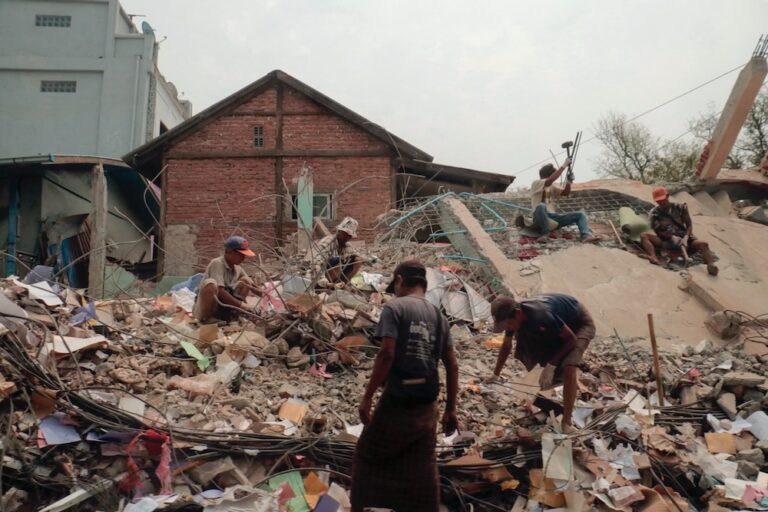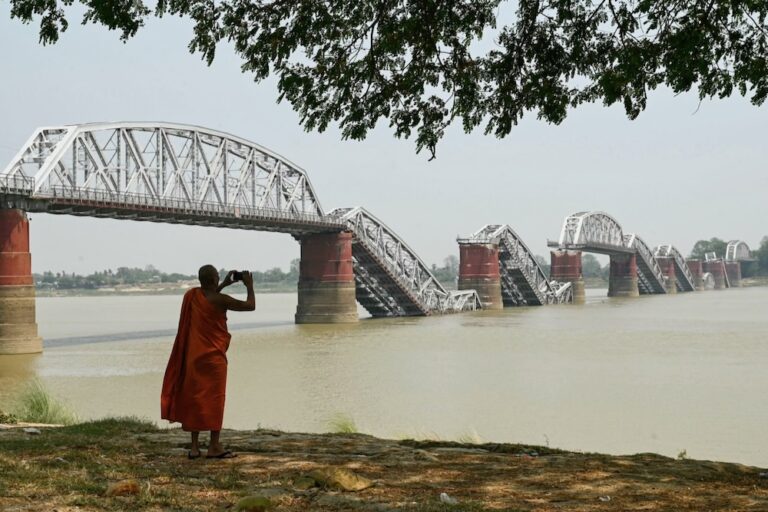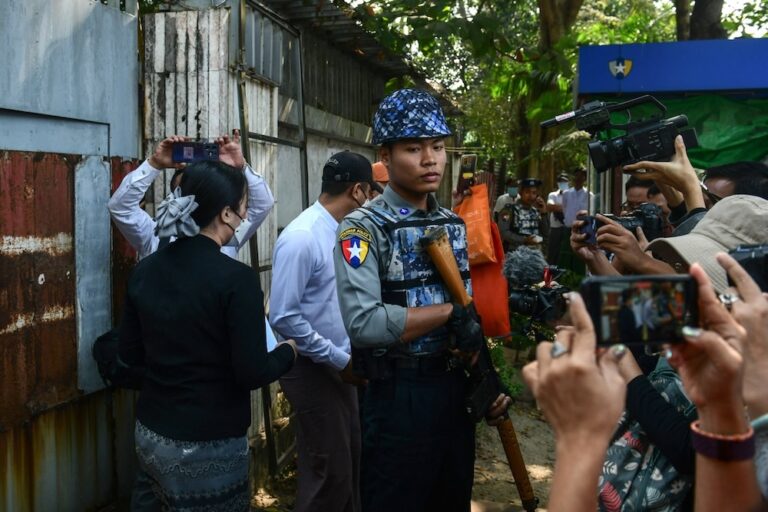Reporters in Burma's ethnic minority regions often endure extortion and harassment. Women journalists, who are heavily outnumbered by their male counterparts in rural areas, face additional challenges in their reporting.
This statement was originally published on mizzima.com on 3 February 2015.
Ma Shanmalay was standing outside her home in Taunggyi one cool evening in January 2013 when she was attacked by a young man who slit her cheek with a crude construction tool. Blood was everywhere, recalled Ma Shanmalay, a reporter for the Shan Herald Agency for News, who days before had broken a story about police corruption. It implicated her assailant’s father, a police officer. Ma Shanmalay had her face cut open for doing her job as a journalist.
It is especially challenging for a woman to be a reporter in Taunggyi, where there are two women journalists, Ma Shanmalay told Mizzima in an interview in Yangon. Although it was common for male colleagues in the Shan State capital to receive threats over the phone, she was the only journalist to have been physically attacked, Ma Shanmalay said.
Ma Shanmalay is among seven journalists from throughout the country participating in Strengthening Ethnic Voices Myanmar, a two-year project launched last year by the Bangkok-based Southeast Asian Press Alliance and Burma News International based in Chiang Mai.
The aims of the project, which has focused its activities in Myanmar’s seven states, include strengthening the capacity of independent ethnic media groups to contribute to the peace process.
The project is another sign of the increased media freedom since the change of government in 2011, including the lifting of pre-publication censorship the following year.
The country’s burgeoning media sector has about 5,000 professional journalists, Myanmar Journalist Network general secretary U Myint Kyaw told Mizzima in an interview, but he was unsure about the number of women reporters. Based on a list of participants in a training course conducted by the network in 2013, U Myint Kyaw estimated there were no more than 20 women journalists working in each outlying region of the country, including Rakhine State and Sagaing Region.
Although many journalists in big cities proudly carry press passes and use bylines, reporters in ethnic minority regions often endure extortion and harassment. Women journalists, who are heavily outnumbered by male counterparts in rural Myanmar and who battle discrimination and sexist cultural norms wherever they work, face unseen challenges reporting on the underreported.
A ‘messy’ media landscape
Ma Shanmalay, who became a reporter in 2013 and writes under a pseudonym, pressed charges against her assailant, but the court case dragged on for more than a year and the charges were eventually dropped. The incident damaged Ma Shanmalay’s relationship with the police in Taunggyi. She interviews police officers in company with other journalists because they refuse to speak with her alone.
Fearing harassment, abuse or worse, Ma Shanmalay is sitting on a story about police corruption in the Shan State capital. “I have a big tip-off about police em-bezzlement … but if I write that story they will harm me for sure. That’s why I keep holding that story,” she said.
Working as a journalist in Shan State is further complicated by the activists, politicians and members of the military who masquerade as reporters, said Ma Shanmalay. A special military intelligence unit focusses solely on “counter-attacking” news and information, she said, citing as an example the military-linked and Facebook-based Taunggyi Media.
“They have their own website and own guys disguised as journalists. They have their own cameras, recorders, phones. They have journalist business cards,” she said.
“We professional journalists know each other. We know who is a journalist and who is not.”
When stories break, the military-linked “fake” journalists often arrive first at the scene and urge villagers not to speak to other journalists, Ma Shanmalay said.
“So when we arrive on the scene and ask the villagers, they are hostile and they say ‘You are not journalists, we cannot answer.’ It is very messy.”
Ma Shanmalay, who had travelled to Yangon to participate in a Strengthening Ethnic Voices Myanmar training course, said she expected to be interrogated by the authorities when she returned to Taunggyi. She was undaunted by the prospect because of her fierce dedication to her work.
“Everybody knows about what happens in Yangon, but few people know about what happens in Shan State. We receive a lot of complaints from the local people and villagers and we need to follow these stories and write the news,” she said. “That’s why we do what we do.”
Restricted access
After villagers in Kayah State protested in 2012 against plans by an ethnic militia to open a tin and tungsten mine at Mawchi, Ma Soe Soe Htet, then a freelancer, interviewed environmental experts for a Kantarawaddy Times story about the project’s potential impact on the area. After the story resulted in more protests that eventually led to the cancellation of the project, Ma Soe Soe Htet received threatening phone calls from members of the militia.
She is among six women journalists who work in Kayah State, a challenging environment for reporters mainly because of the distrust between its rural population and local authorities. To travel to rural areas, journalists need permission from local authorities.
Because of a lack of transport and safety concerns about travelling alone, journalists tend to join trips by civil society groups to their project sites in exchange for a story promoting the project, said Ma Soe Soe Htet.
Ma Soe Soe Htet, who had freelanced for the Kantarawddy Times while working for a non-government group that required extensive travel in Kayah State, began working full-time for the paper in 2013. The next year she became editor-in-chief of the monthly publication, which was launched on the Thai border in 2004 and officially registered in Myanmar in 2013. As well as well as writing and editing, she manages a team of six reporters and handles distribution.
“I am so passionate about this job. If the funding stopped, I could handle operations. I know how to chase and write news. I just need money for publication,” she told Mizzima.
About 1,500 to 2,000 copies of the Kantarawaddy Times are distributed each month and Ma Soe Soe Htet often leaves bundles of the paper in remote villages, despite transport costs often exceeding sales revenue.
Before 2013 Ma Soe Soe Htet was the only woman journalist in Kayah State.
“It was a male dominated industry, people felt strained when they saw a woman with a camera asking questions. They wondered who the hell I was … I felt insecure and embarrassed and lonely,” she said. “Now I have a [female] colleague so it is better – but I still don’t use a byline.”
Pressing on
Rushing to get a shot of Daw Aung San Suu Kyi addressing supporters during the 2012 by-election campaign, Ma Seng Mai, then a freelance journalist, climbed on to an elevated platform reserved for the media.
As she pushed her way to the front of the media pack, an amplified voice demanded through a loudspeaker that she and another women journalist get down immediately: they had breached the cultural taboo of having placed themselves higher than monks in the crowd.
“I was pissed off, I am a journalist and I need to sell my stuff,” said Ma Seng Mai, who missed the shot, a huge loss for a freelancer, who depends on each job for income.
Ma Seng Mai, who began her career in 2008 as a clandestine journalist working for outlets including the Myanmar Times and the BBC, gave up freelance work in February 2014 when she founded the Myitkyina Journal, of which she is also editor-in-chief.
Though she often faces gender discrimination, Ma Seng Mai said she has yet to be harassed or threatened.
“Probably because I look tough,” she said with a laugh. Ma Seng Mai said Kachinland News, a Kachin news agency, has one woman reporter on its staff whereas Myitkyina Journal is staffed by fifteen women and ten men.
“I am the owner and the founder, so I hire mainly women,” she said.
Women journalists are filling newsrooms, launching newspapers and assuming senior editorial positions through Myanmar, even in its remotest corners.
At Falam in Chin State, Mai Sui Kuk is a reporter and editor for the state’s National Races Channel, broadcast by state-run Myanmar Radio and Television.
One of her challenges is disruptions to the electricity supply.
“Now the power is out, my laptop is on low battery and I have to edit news and send it,” Mai Sui Kuk, told Mizzima by email, adding that she accesses the internet through a smartphone.
“Power will be back at 9pm and until then, I wait sitting by the fire.”



